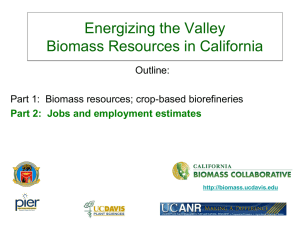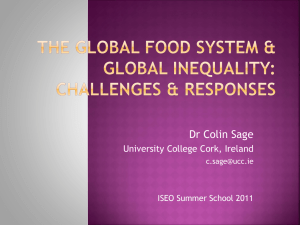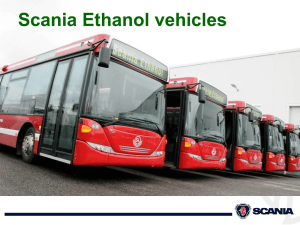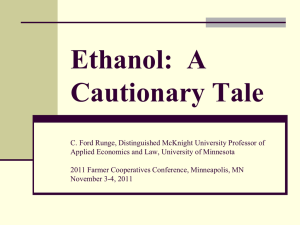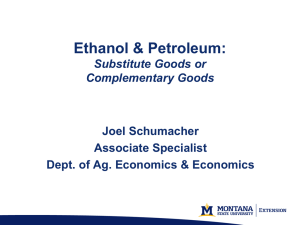Document
advertisement
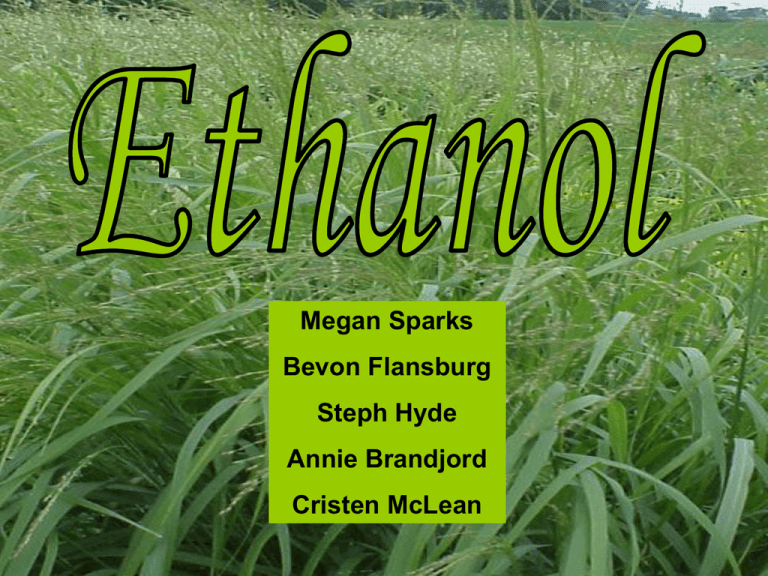
Megan Sparks Bevon Flansburg Steph Hyde Annie Brandjord Cristen McLean I’m cute! O H H O C C H H H H C H (http://en.wikipedia.org/wiki/Image:Ethanol-3D-vdW.png) E10: 10% ethanol 90% gasoline. E85: 85% ethanol 15% gasoline. E85 can be used in flexible fuel vehicles (FFVs). (http://www.ethanol.org) “Ethanol” generally means grain alcohol. Sources: corn (primary source in U.S.) other grains potatoes sugarcane (e.g. Brazil) (http://www.ethanol.org) Cellulosic ethanol is made from cellulose (surprise!) Cellulose provides structure to plants. Sources: corn stover, sugar cane bagasse, sawdust, paper pulp, and switchgrass. (Brekke 2005) (http://en.wikipedia.org/wiki/Image:Cellulose-3D-balls.png) 1) Milling (grind it up!) 2) Liquification (mixed with H2O and heated) 3) Saccharification (starch fermentable sugars) 4) Fermentation (yeast + sugars = ethanol + CO2) 5) Distillation (ethanol is separated from the solids) 6) Dehydration (remove last bit of H2O) 7) Denaturing (made unfit for human consumption) 8) Co-products (distiller’s grain CO2 livestock feed compressed) (http://www.ethanol.org) 1) Treat with heat and acid to break it apart 2) Treat with enzymes to turn the sugars into fermentable glucose Enzymes now 10-18 cents / gallon in laboratory trials. Bacteria…? Lonnie Ingram (University of Florida) E. coli + cellulose ethanol 90 – 95 % efficiency (Brekke 2005) www.fuga.ru/tok/2003/11/e-coli-small.jpg Yields 25 % more energy than is used to grow, harvest and distill it into ethanol. Energy output:input ratio = 1.6 (http://www.eere.energy.gov/afdc/altfuel/eth_energy_bal.html) Gasoline E85 Ethanol Octane Number 86 to 94 100 Main Fuel Source Crude Oil Energy Content / Gallon 109,000 125,000 Btu Corn, Grains, or agricultural waste ~ 80,000 Btu Energy Ratio Compared to Gasoline Physical State 70% Liquid Liquid (http://www.eere.energy.gov/afdc/progs/fuel_compare.cgi) Emissions and Air Quality • Ethanol contains 35% oxygen. Adding oxygen to fuel results in more complete fuel combustion • Gasoline containing a 10% ethanol blend reduces smog emissions – carbon monoxide 25-30% – particulate matter 50% – volatile organic compounds 7%. http://www.greenfuels.org/ethanol/envbenefits.htm Emissions from Ethanol Plants Most ethanol plants emit < 100 tons of pollutants as compared to >20,000 tons produced by an averagesized power plant each year http://www.ethanol.org/talkingpoints.html ‘Recycling’ CO2 • -CO2 co-product is compressed and sold to carbonate beverages, manufacture dry ice, and flash freeze meat. • Miscible CO2 flooding. http://www.ethanolrfa.org/resource/facts/environment/; http://www.ethanol.org/carbondioxide.html Feasibility • Since 1999, an increasing number of FFVs manufactured. • Increasing economic feasibility. http://www.eere.energy.gov/afdc/altfuel/ethanol.html Benefits: Internal Economic • USDA estimates 2012 corn demand= 2 billion Bushels • Plant construction creates 370 local jobs ($60-130M income) • Plant operation creates 4,000 local jobs ($47-100M income) Benefits: More Internal • Necessary to continue to meet rising EPA standards • 95% of gas already has 6% ethanol Benefits: External Economic • Self-sufficiency! • Potential 1/3 reduction of foreign oil dependence • W/o E10, immediate 3% need increase So, Who’s Buying It? • 2003- Global Summit including representatives from China, India, Thailand, and Brazil • “In poor countries, production of ethanol and biodiesel can have an extremely positive impact. It assists in dealing with the energy deficit, influencing internal consumption and exports. It can also generate a vast number of jobs.” - President da Silva, Brazil E3 Biofuels (Mead, NE) • • • • Grow Corn Produce Ethanol Feed Cattle Harvest the manure • Produce methane • Methane fuels boilers • Remains-Fertlize soil Domestic Production • American Made Fuel 2006 – 105 plants in operation-1/2 locally owned=5 billion gal/year 48 New or Improved on line=7.9 billion gal/year Annual Projections for Cellulosic Ethanol 50 billion gallons Waste (Agricultural, Industrial, MSW) 40%-50% USDA&E Estimate 80 billion gal. potential 1/3 transportation energy By 2050 Switchgrass on 114 million acres 165 billion gal. ethanol=108 billion gal. gasoline http://www.nrdc.org/air/energy/biofuels/contents.asp, http://www.harvestcleanenergy.org www.energy.ca.gov/reports Natural Resource Defense Council (NRDC) Growing Energy Improve conversion efficiencies 50 to 117 gal. ethanol / 1dry ton of biomass Produce animal proteins from switchgrass (capable of producing I billion tons of sustainable biomass/year) http://www.nrdc.org/air/energy/biofuels/contents.asp, http://www.harvestcleanenergy.org http://www.ethanolrfa.org/resource/cellulose Goals and Future Usage …Yes, they really are out there. Implementation of Waste Processing • Industrial waste/municipal solid waste as definite source of energy. – Dartmouth project (paper sludge to ethanol). – Masada Oxynol, Middletown, NY (MSW to ethanol). • Reduces or eliminates capacity problems at wastewater plants and the need for landfills. Landfill Use • 1990: 247 million tons of non-hazardous waste. • 2001: 409 million tons. • Use of MSW opens new framework of raw materials, minimizes land charted for feedstock cultivation. http://www.zerowasteamerica.org/La ndfills.htm Current proposals • Natural Resource Defense Council: – Invest in research, development, general demonstration ($1.1 billion). – Invest in deployment ($1 billion 2006-2015; prices to approach diesel/regular gasoline). – Adopt policies to establish infrastructure and a market (RF standards, FFV req’s) http://www.nrdc.org/air/energy/pump/ contents.asp Incentives/Laws • State and federallevel tax/loan benefits to encourage the use of alternative fuels. • Mandates require purchase of AFVs whenever economically or logistically possible. www.irs.gov/publications/p378/ar01.html. Table: http://www.nrdc.org/air/energy/rep/chap1.asp



